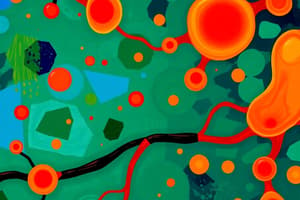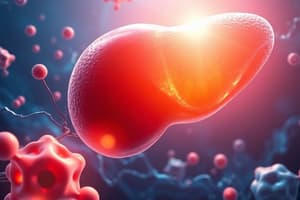Podcast
Questions and Answers
What are the 4 main classes of lipoproteins?
What are the 4 main classes of lipoproteins?
- Low Density Lipoproteins (correct)
- High Density Lipoproteins (correct)
- Very Low Density Lipoproteins (correct)
- Chylomicrons (correct)
What is the function of chylomicrons?
What is the function of chylomicrons?
Transport of dietary lipids
Where do chylomicrons originate?
Where do chylomicrons originate?
Small intestine
What stimulates chylomicron synthesis?
What stimulates chylomicron synthesis?
What interactions do chylomicrons have?
What interactions do chylomicrons have?
What is the destination of chylomicrons?
What is the destination of chylomicrons?
What is the function of VLDL?
What is the function of VLDL?
Where does VLDL originate?
Where does VLDL originate?
What stimulates VLDL synthesis?
What stimulates VLDL synthesis?
What is the destination of VLDL?
What is the destination of VLDL?
What is the function of LDL?
What is the function of LDL?
Where does LDL originate?
Where does LDL originate?
What stimulates LDL synthesis?
What stimulates LDL synthesis?
What is the destination of LDL?
What is the destination of LDL?
What do LDL receptors recognize?
What do LDL receptors recognize?
What blocks LDL receptors?
What blocks LDL receptors?
What is the function of HDL?
What is the function of HDL?
Where does HDL originate?
Where does HDL originate?
What stimulates HDL synthesis?
What stimulates HDL synthesis?
What is the destination of HDL?
What is the destination of HDL?
Flashcards are hidden until you start studying
Study Notes
Classes of Lipoproteins
- Four main classes of lipoproteins: chylomicrons, very low density lipoproteins (VLDL), low density lipoproteins (LDL), and high density lipoproteins (HDL).
Chylomicrons
- Function: Transport dietary lipids from the intestines to other parts of the body.
- Origin: Produced in the small intestine after consuming dietary fats.
- Synthesis: Stimulated by the presence of dietary fat.
- Interactions: Undergoes exchange of apoproteins with HDL and lipolysis via lipoprotein lipase (LPL).
- Destination: Stored in adipose (fat) tissue; delivers cholesterol to the liver.
Very Low Density Lipoproteins (VLDL)
- Function: Transports endogenously synthesized lipids, primarily triglycerides.
- Origin: Synthesized in the liver.
- Synthesis: Stimulated by caloric excess, insulin, estrogens, and ethanol (EtOH).
- Destination: Stored in adipose tissue, used for fatty acid oxidation in most cells, and converted into serum intermediate-density lipoproteins (IDL) and subsequently LDL.
Low Density Lipoproteins (LDL)
- Function: Responsible for transporting cholesterol esters to various tissues.
- Origin: Formed through metabolism of VLDL.
- Synthesis: Stimulated by insulin, thyroxin, and steroid hormones.
- Destination: Deliver cholesterol to most tissues, excluding the brain and blood cells; primarily taken up by blood vessels and the liver.
- Receptor Recognition: LDL receptors recognize ApoB-100 protein.
- Receptor Blockage: Blocked by ApoE present in chylomicrons.
High Density Lipoproteins (HDL)
- Function: Mediates the return of excess tissue cholesterol back to the liver.
- Origin: Synthesized in the liver.
- Synthesis: Stimulated by dietary fats, estrogens, exercise, and ethanol (EtOH).
- Destination: Primarily travels to the liver and steroidogenic tissues for cholesterol recycling.
Studying That Suits You
Use AI to generate personalized quizzes and flashcards to suit your learning preferences.




